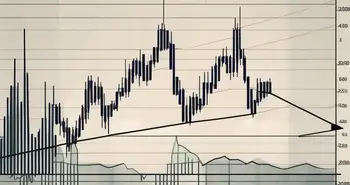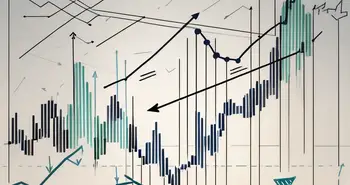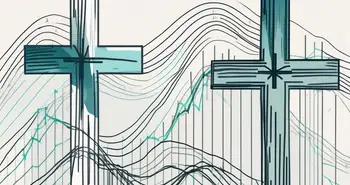Bull Pennant vs Bear Pennant: Key Differences Explained

Trading patterns can provide valuable insights into market trends and help investors make informed decisions. One common pattern that traders often encounter is the bull pennant and the bear pennant. While these patterns may seem similar at first glance, there are key differences that traders should be aware of. In this article, we will explore the basics of trading patterns, the formation of bull and bear pennants, the key differences between them, and how to interpret these patterns for successful trading.
Understanding the Basics of Trading Patterns
Before diving into the specifics of bull and bear pennants, it's important to understand the basics of trading patterns. Trading patterns are visual representations of price movements that have historically occurred in the market. These patterns can help traders identify potential trend reversals, breakouts, or continuations.
Traders analyze patterns using technical analysis tools such as support and resistance levels, trendlines, and moving averages. By recognizing specific patterns, traders can anticipate future price movements and make more informed trading decisions.
What is a Bull Pennant?
A bull pennant is a bullish continuation pattern that forms after a strong upward price movement. It is characterized by a small symmetrical triangle, also known as a flag, that slopes upward. The flag is formed by two trendlines that converge, creating a consolidation phase.
What is a Bear Pennant?
On the other hand, a bear pennant is a bearish continuation pattern that forms after a strong downward price movement. Similar to a bull pennant, a bear pennant consists of a small symmetrical triangle, or a flag, that slopes downward. The flag is formed by two trendlines that converge, indicating a period of consolidation.
The Formation of Bull and Bear Pennants
The formation of bull and bear pennants follows a similar pattern, with some key differences based on the prevailing market conditions. Understanding how these patterns are formed is crucial in interpreting their implications for future price movements.
How Bull Pennants are Formed
Bull pennants are formed as a result of a strong upward price movement, known as the pole. The pole is typically formed by a sharp increase in price followed by a period of consolidation. During this consolidation phase, the flag is created as the price consolidates within a smaller range, forming two converging trendlines.
As the consolidation phase progresses, volume tends to decrease, indicating a temporary balance between buyers and sellers. Traders interpret the formation of a bull pennant as a sign of bullish continuation, suggesting that the upward trend is likely to resume once the price breaks out of the pattern.
How Bear Pennants are Formed
Similarly, bear pennants are formed after a substantial downward price movement, forming a pole followed by a period of consolidation. The flag, consisting of two converging trendlines, is created as the price range narrows during the consolidation phase.
As volume decreases during the consolidation phase, it signifies a temporary equilibrium between buyers and sellers. The formation of a bear pennant implies a bearish continuation, suggesting that the downward trend is likely to resume once the price breaks out of the pattern.
Key Differences between Bull and Bear Pennants
While both bull and bear pennants represent periods of consolidation before the continuation of an existing trend, there are distinct differences between these patterns that traders should consider.
Difference in Market Conditions
Bull pennants often occur in bullish market conditions when the overall sentiment is positive. These patterns are typically observed during uptrends, indicating a temporary pause or consolidation before the price resumes its upward movement.
On the other hand, bear pennants tend to emerge in bearish market conditions when the sentiment is negative. These patterns are commonly found during downtrends, signifying a temporary consolidation before the price resumes its downward movement.
Difference in Price Movements
Another difference lies in the price movements that precede the formation of bull and bear pennants. Bull pennants are typically preceded by a strong upward price movement, indicating bullish momentum in the market. The consolidation phase represents a period of rest before the buyers regain control and push the price higher.
In contrast, bear pennants form after a significant downward price movement, suggesting bearish momentum. The consolidation phase allows sellers to take a breather before resuming their selling pressure and driving the price lower.
Difference in Investor Sentiment
It's important to consider investor sentiment when analyzing bull and bear pennants, as it can provide valuable insights into market psychology. Bull pennants often create a sense of optimism and confidence among investors, leading to an increase in buying interest as the price breaks out of the pattern.
Conversely, bear pennants instill fear and pessimism among investors, resulting in increased selling pressure once the price breaks out of the pattern.
Interpreting Bull and Bear Pennants
Successfully interpreting bull and bear pennants can be a valuable tool for traders. By understanding the implications of these patterns, traders can formulate effective trading strategies and increase their chances of profitable trades.
How to Trade Bull Pennants
When trading bull pennants, traders often wait for a breakout above the upper trendline of the pattern as a confirmation of bullish continuation. They may enter a long position once the price breaks out, placing a stop-loss order below the lower trendline.
Furthermore, traders may consider factors such as volume, moving averages, and other technical indicators to assess the strength of the breakout and potential targets for profit-taking.
How to Trade Bear Pennants
Trading bear pennants involves waiting for a breakout below the lower trendline of the pattern, signaling bearish continuation. Traders may enter a short position once the price breaks below the trendline, placing a stop-loss order above the upper trendline.
Similar to trading bull pennants, traders may utilize other technical indicators and consider volume and moving averages to gauge the strength of the breakout and identify potential profit targets.
Risks and Considerations in Trading Pennants
While trading bull and bear pennants can offer profitable opportunities, it's important to be aware of the associated risks and considerations.
Potential Risks of Bull Pennants
One potential risk when trading bull pennants is a false breakout. Sometimes, the price may break above the upper trendline only to reverse and move in the opposite direction.
To mitigate this risk, traders should wait for a clear and decisive breakout, supported by increasing volume and other confirming technical indicators.
Potential Risks of Bear Pennants
When trading bear pennants, a potential risk is a false breakout below the lower trendline. The price may briefly break below the trendline before reversing and moving upwards.
To minimize this risk, traders should look for a strong breakout with high volume and additional confirmation from technical indicators before entering a short position.
As an expert in trading patterns, I have personally witnessed the effectiveness of bull and bear pennants in predicting market movements. I recall a specific instance where I identified a bull pennant forming on a stock chart. After conducting thorough analysis, considering the prevailing market conditions and investor sentiment, I decided to enter a long position once the price broke above the upper trendline of the pattern.
The breakout proved successful, and the stock continued its upward journey, resulting in a significant profit. This experience highlights the importance of understanding and utilizing trading patterns effectively to seize profitable opportunities in the market.
In conclusion, bull and bear pennants are distinct trading patterns that offer valuable insights into market trends and price movements. Understanding the formation, key differences, and interpretation of these patterns equips traders with the necessary tools to make informed trading decisions. By recognizing the unique characteristics of bull and bear pennants, traders can enhance their trading strategies and capitalize on profitable opportunities in the market.
Ready to put your knowledge of bull and bear pennants into practice? Join Morpher, the revolutionary trading platform that leverages blockchain technology to offer zero fees, infinite liquidity, and a unique trading experience. Whether you're looking to trade stocks, cryptocurrencies, forex, or even niche markets like NFTs, Morpher provides the tools for success. Sign up now and take advantage of fractional investing, short selling without interest fees, and up to 10x leverage to amplify your trades. Plus, with the Morpher Wallet, you'll enjoy unmatched safety and control over your investments. Don't miss out on this innovative approach to trading. Sign Up and Get Your Free Sign Up Bonus today and start trading the smart way with Morpher!

Disclaimer: All investments involve risk, and the past performance of a security, industry, sector, market, financial product, trading strategy, or individual’s trading does not guarantee future results or returns. Investors are fully responsible for any investment decisions they make. Such decisions should be based solely on an evaluation of their financial circumstances, investment objectives, risk tolerance, and liquidity needs. This post does not constitute investment advice.

Painless trading for everyone
Hundreds of markets all in one place - Apple, Bitcoin, Gold, Watches, NFTs, Sneakers and so much more.

Painless trading for everyone
Hundreds of markets all in one place - Apple, Bitcoin, Gold, Watches, NFTs, Sneakers and so much more.









